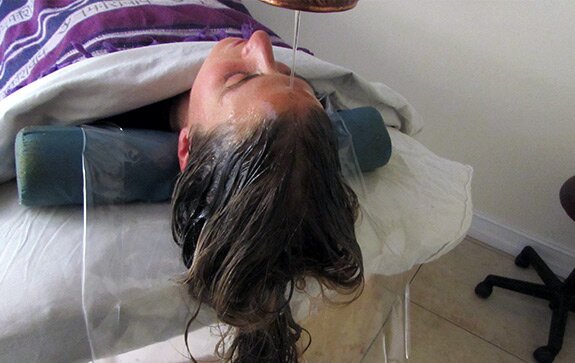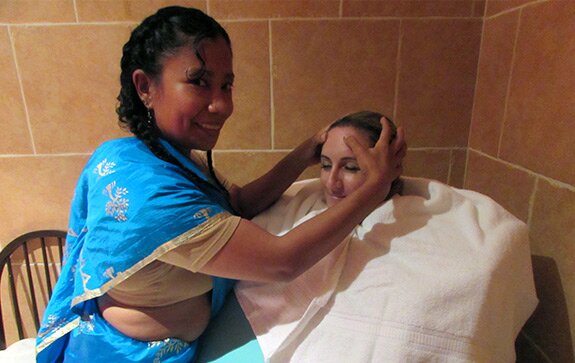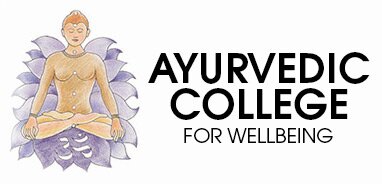Vidya Light is supervising PK in Puerto Rico with a team of PK Specialists. She still conducts daily pulse diagnosis, leads yoga and enjoys cooking, but allows the team to do everything else.
 Pancha Karma is a complete Ayurvedic lifestyle and educational program based on the Science of Life and sessions are normally experienced during the change of seasons. These Pancha Karma cleansing and rejuvenating sessions can be provided at our Ayurvedic Retreat Center or in the comfort of your home.
Pancha Karma is a complete Ayurvedic lifestyle and educational program based on the Science of Life and sessions are normally experienced during the change of seasons. These Pancha Karma cleansing and rejuvenating sessions can be provided at our Ayurvedic Retreat Center or in the comfort of your home.
Records indicate that Pancha Karma was in practice as early as 300 A.D. and was performed at the turn of the seasons to prepare the body for changes in diet and environmental conditions. Pancha Karma is carefully adapted for each body type and specific conditions. The five actions to purify the body are: Oleation (Sneehana), Purgation (Virechana), Sweats (Swedhana), Enema (Basti), and Nasal Therapy (Nasya).
Some systems include Emesis (Therapeutic Vomiting), Shirodhara, and Tarpana (Relationship Healing) and Oleation (Sneehana.) This self-administered action involves the use of oil taken internally and externally to soften and make supple the tissues of the body so that ama (toxins) can flow freely outward. Ghee, castor oil, or medicated oils are used to prepare the digestive tract for cleansing. External use of oils loosens and softens the external channels (pores, sebaceous glands, lymph, and capillaries) and prepares them for cleansing through sweating.
This Pancha Karma Program emphasizes lifestyle coaching and self-administered methods for prevention and longevity. Your days will be filled with activities that enhance well-being.

Light and Bryan will act as mentors who provide support and encouragement for you to assimilate the transformative gifts that Ayurveda offers. A personalized self-care home program is provided to encourage your transformative lifestyle experience.
You will learn:
- How to strengthen your body with yoga asanas for your body type.
- A practice of forgiveness that addresses relationship and ancestor patterns.
- Self-inquiry on your personal patterns of behavior.
- How to break old habit patterns and addictions with a lifestyle consultation.
- How to set goals for yourself.
- How to nurture yourself and others.
- Clarity on your life purpose and steps to actualize it.
- How to develop harmony and bliss.
- You will learn that when you take time for yourself, you will have more energy, more patience, more compassion, and more joy to share with others.
For the Fall & Winter, Ayurvedic Healers will be offering the packages below. Our focus is on you and what your body calls for. Each package can be redesigned for your body, soul, and mind’s yearning.


- Ayurvedic consultation
- Yoga
- Meditation
- Swedana – Steam cabinet with essential oils
- Ayurvedic Vegetarian Lunch
- Tea for your body type
- Chakra Anointment – Balance chakras– Centering and expansion
- 2 Colon cleanses
- Skin brushing
- Shirodhara
Recommended for a minimum of 5 days up to 30 days. We will work with you to create arrangements for local accommodations. We also have humble accommodations at the Center.
You will receive personalized attention 6 to 7 hours each day.
The cost of the Perfect Weight Pancha Karma is $450.00 per day
- Ayurvedic Consultation
- Yoga
- Meditation
- Swedana – Steam cabinet with essential oils
- Ayurvedic Vegetarian Lunch
- Perfect Weight Tea
- Chakra Anointment – Balance chakras – Centering and expansion
- 3 Colon cleanses
- Tandam (4 hands) Massage
- Tarpana – Relationship healing, emotional release
- Personalized diet plan to achieve your perfect weight
- Lepa – Herbal body mask
- Gall Bladder Cleanse
- Body Wraps
Delux Pancha Karma
- Ayurvedic Consultation
- Yoga
- Meditation
- Swedana – Steam cabinet with essential oils
- Ayurvedic Vegetarian Lunch
- Your body type tea
- Chakra Anointment – Balance chakras – Centering and expansion
- 3 Colon cleanses
- Tandam (4 hands) Message
- Tarpana – Relationship healing, emotional release
- Personalized diet plan to achieve your perfect weight
- Lepa – Herbal body mask
- Gall Bladder Cleanse
Below are further explanations of the services available during a Pancha Karma cleanse.
Everyone is a candidate for Pancha Karma – these yogic therapies have been used since ancient time to cleanse the body and for the prevention of disease.
The Chakras are our energy anatomy. At the end of the day of healing, chakras are anointed to bring balance, bliss, and harmony to the ethereal, physical, and emotional body. Give yourself 3, 5, or 7 days of rejuvenation, better health, stress reduction, energy, vitality, and peace.
Pancha Karma Therapy
Innovation can even emerge from diminishing choices. Our teacher, Dr. Chotai, related a difficult case of skin cancer, where traditional medical and Ayurvedic approaches had been exhausted. Pulse diagnosis revealed a dry, irregular predominant vàta. Seeking the greatest application of earth element, he intuited that earth burial could be the ultimate delivery mechanism. The patient was buried vertically in the sand of Santa Cruz Beach, Mumbai, with an umbrella to protect her head from the sun and only fresh coconut water (water element) for consumption. He sat with her for ten days, drifting from light conversation to deep meditation to silent observation of the horizon and sleep. When the patient emerged from the sand, the lesions were resolved and her pulse had achieved balance.
We are both re-born ayurvedic practitioners. We have done this before. It is too easy, too familiar to us not to have been practitioners in a previous life. We have appreciated the traditional methodologies, yet never felt an obligation to stick to them. Our abhyanga massage may have components of cross-fiber, lymph drainage, trigger points, and chiropractics in addition to traditional marma and abhyanga strokes. We use whatever is needed. For example, I like my sirodhàra, heated, temperature regulated, directed, and controlled with gentle chanting in the background.
The following are some ways that we have customized our patients’ pancha karma (PK) treatments. We hope there is something here for practitioners in the field.
Abhyanga oil can be created from a small collection of essential oils and vegetable base oils. Essential oils are lighter and more concentrated than traditional medicated oils, which can take months to prepare. With knowledge and intent, the practitioner can instantly blend for a specific dosha reduction or to support any associated conditions or symptoms.
For example, in a patient with excess pita and skin inflammation, a base of coconut oil could be added essential oils (EO) of blue chamomile, yarrow, sandalwood, and lavender for a cooling, calming abhyaïga blend. In addition to promoting localized skin healing, these oils would be absorbed into circulation, calming the nervous system, quieting the mind, and even balancing the endocrine system. There is nothing that would preclude the use of traditional medicated oils in your blends.
Sirodhàra oil can be similarly made patient specific, although its direct absorption is reduced since only the top of the head is contacted by the oil. However, smell receptors in the nasal palate directly stimulate the limbic system and can release a stream of withheld memories, emotions, and desires. The combination of appropriate EOs with Sirodhàra’s lucid dreaming potential could be well worth exploring.
Steam treatment can also be enhanced with essential oils of eucalyptus, rosemary, juniper, ravensara, and cypress, with little regard to doshic influence as the vapors contacting the skin have a local, fleeting, rather than systemic effect. Adding 20-30 drops of a single oil or mixture to the Steamy Wonder or steam cabinet adds herbal energetics to the cleansing power of steam. Patients love to receive a simultaneous head massage with bràhmi oil during steam treatment.
Traditional vasti treatments, for some PK patients, can trigger negative emotional memories from childhood toilet training, early constipation experiences, or negative associations with natural body functions. This can add unwanted tension to a treatment that requires relaxation. The patient can experience anxiety when arising from the floor upon reaching their holding limit, while contemplating the potential for an accident when mobilizing to the restroom.
We circumvent much of this by use of colema board for vasti therapy. This method was brought to the west by Dr. Bernard Jensen, N.D., who rediscovered it on a visit to Nisargopchar Ashram Nature Cure Centre (Uruli) near Pune, India.
Coincidentally, this center was founded by Mahatma Gandhi, Dr. Chotai, and others to reestablish Natural Treatments post-Independence. Designed for home use, the colema board allows the patient to recline supine, draped for privacy, have their abdomen massaged, and not have to get up. A four gallon tank can deliver gravity-fed triphalà tea or any vasti mixture you desire. For instance, we add Pau d’Arco, neem, or black walnut hull to the tea, if we suspect candidiasis or parasites.
Additionally, a custom barbed “Y” fitting can be added to the terminal delivery tubing, allowing body temperature sesame oil (one to three ounces) to be injected with a catheter-tip syringe, directly into the emptied colon to prevent post-treatment dryness. This form of vasti takes 30 to 60 minutes. Patients who have experienced both traditional and colema vasti often express preference for the latter. In cases of extremely dry or inactive colons, we still use a traditional retention vasti with four to six ounces of lukewarm sesame oil, with good results.
Vamana (therapeutic vomiting), virecana (purgation), and gall bladder flush are treatments that can be challenging, emotional, and time consuming. They are often not included in PK for these reasons, yet they may be the very thing that the patient needs.
We find that one in ten PK patients need vamana, one in four need virecana, and one in five need a gall bladder flush. Pulse detection, with the classic associated symptomatology is diagnostic.
These delicate therapies should be learned from a master, practiced under supervision, and applied only where indicated. The ancient apprenticeship method of teaching, gurukula, which means “becoming family to the teacher,” was once the only way to master these treatments and may well still be the best way.
Article by DR. Bryan Miller in Light On Ayurveda Journal
We give each PK patient four cups of vegetable/fruit/herb juice each day and a shot glass of wheatgrass juice. These practices also come from our teacher Dr. Chotai and his Aruli nature-cure practice. He is credited by Dr. Anne Wigmore with teaching her much about wheatgrass. He was especially fond of giving his patients fresh extracted tulsã (basil) juice and still dispenses wheatgrass (at 126 years old). Carrot, celery, beet, cucumber, fennel bulb, apple, pineapple, cilantro, ginger, parsley, and mint are a few of the common ingredients to choose from when designing a juice for a specific dosha or condition. I prefer to serve the wheatgrass separately as it can overshadow any juice blend. These fresh juices are full of pràna, enzymes, and nutrients. They can be tasteful, easy to absorb, satisfying, and assist with removal of the àma (toxins) stirred up by PK. The chlorophyll found in all greens, and especially in cilantro and wheatgrass, has a chelating effect (grabs and escorts out) on heavy metals like mercury.
I encountered one PK patient who had been hospitalized with seizures and took a year to recover after cleansing (not PK) with distilled water. Between the herb teas, juices, food and spring water, I have never seen drops in the electrolyte levels of our PK clients.
* Based on the calculations of when modern pollution may show up in the spring’s aquifer.
In the PK food department, we go light for the first three days with fresh organic fruit salads (morning) and a nourishing, blended vegetable/herb/seaweed soup (immune soup) we serve with ghee (lunch and dinner). For the last four days, our kitchen goes full on, serving gourmet vegetarian with everything from quinoa khichri and spinach curry sauce to cashew-herb stuffed butternut squash. After seven days, patients leave, excited about new healthy cuisine possibilities and with Light’s new 500+ page cookbook** in hand. If patients take their newly learned diet and daily regimens home with them, they will stay healthy. Their friends and family will be asking them about their obvious good changes in looks and behavior. Mountain Valley Spring Water.
Swamini Mother Mayatitananda writes,
Without realizing it, we often carry the ancestors on our backs. Because their memory patterns are deeply embedded within our vital tissues and cells, we continually reenact patterns that originate in the history and memory of our family lines. When we do not recognize ancestral traumas, we are likely to ferry them into every aspect of our lives. But we can resolve our karmic history through honoring ancestors; we can trade hurt and grief and illness for celestial guidance.
_______________________
** Soon to be released by Lotus Press.
*** This link references an article by Dr. Robert Svoboda for a detailed description of the traditional ceremonial tarpana: www.hinduism.co.za/tarpana.htm
Pancha Karma services are also offered individually. See Treatments page for more information.
